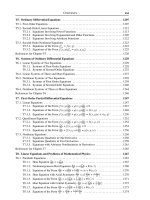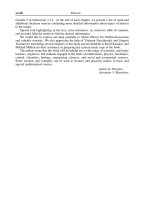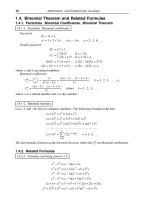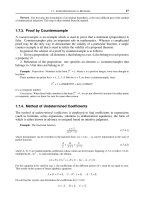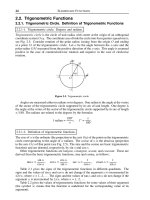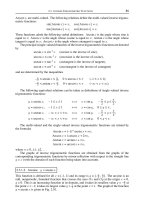Handbook of mathematics for engineers and scienteists part 21 pptx
Bạn đang xem bản rút gọn của tài liệu. Xem và tải ngay bản đầy đủ của tài liệu tại đây (410.23 KB, 7 trang )
108 ANALYTIC GEOMETRY
whose values do not change under parallel translation and rotation of the coordinate axes,
and the semi-invariant
σ =
a
22
a
23
a
32
a
33
+
a
11
a
13
a
31
a
33
,(4.4.5.3)
whose value does not change under rotation of the coordinate axes.
The invariant Δ is called the large discriminant of equation (4.4.2.1). The invariant δ
is called the small discriminant.
Table 1 presents the classification of second-order curves based on invariants.
TABLE 4.1
Classification of second-order curves
Type
Δ ≠ 0
Δ = 0
Δ
I
> 0
Real ellipse (for I
2
= 4δ or a
11
= a
22
and a
12
= 0,thisisacircle)
Elliptic
δ > 0
Pair of imaginary straight lines intersecting at
a real point (ellipse degenerating into a point)
Δ
I
< 0
Imaginary ellipse (no real points)
Hyperbolic
δ < 0
Hyperbola
Pair of real intersecting straight lines
(degenerate hyperbola)
σ > 0
Pair of imaginary parallel straight lines
σ < 0
Pair of real parallel straight lines
Parabolic
δ = 0
Parabola
σ = 0
Pair of coinciding straight lines
(a single straight line)
4.4.5-4. Characteristic equation of second-order curves.
The properties of second-order curves can be studied with the use of the characteristic
equation
a
11
– λa
12
a
21
a
22
– λ
= 0 or λ
2
– Iλ + δ = 0.(4.4.5.4)
The roots λ
1
and λ
2
of the characteristic equation (4.4.5.4) are the eigenvalues of the
real symmetric matrix [a
ij
] and, as a consequence, are real.
Obviously, the invariants I and δ of second-order curves are expressed as follows in
terms of the roots λ
1
and λ
2
of the characteristic equation (4.4.5.4):
I = λ
1
+ λ
2
, δ = λ
1
λ
2
.(4.4.5.5)
4.4.5-5. Centers and diameters of second-order curves.
A straight line passing through the midpoints of parallel chords of a second-order curve is
called a diameter of this curve. A diameter is said to be conjugate to the chords (or to the
direction of chords) which it divides into two parts. The diameter conjugate to chords forms
an angle ϕ with the positive direction of the OX-axis and is determined by the equation
(a
11
x + a
12
y + a
13
)cosϕ +(a
21
x + a
22
y + a
23
)sinϕ = 0.(4.4.5.6)
4.4. SECOND-ORDER CURVES 109
All diameters of a second-order curve with δ ≠ 0 meet at a single point called the center
of the curve, and in this case the curve is said to be central. The center coordinates (x
0
, y
0
)
satisfy the system of equations
a
11
x
0
+ a
12
y
0
+ a
13
= 0,
a
21
x
0
+ a
22
y
0
+ a
23
= 0,
(4.4.5.7)
which implies that
x
0
=–
1
δ
a
13
a
12
a
23
a
22
, y
0
=–
1
δ
a
11
a
13
a
21
a
23
.(4.4.5.8)
All diameters of a second-order curve with δ = 0 are parallel or coincide. A second-order
curve does not have a center if and only if δ = 0 and Δ ≠ 0. A second-order curve has a
center line if and only if δ = 0 and Δ = 0.
Example 1. The centers of nine canonical second-order curves are as follows:
1. Ellipse, δ = 1 and Δ =–1: the single center O(0, 0);
2. Hyperbola, δ =–1 and Δ = 1: the single center O(0, 0);
3. Parabola, δ = 0 and Δ =–1: no centers;
4. Imaginary ellipse, δ = 1 and Δ =–1: the single center O(0, 0);
5. Pair of intersecting straight lines, δ =–1 and Δ = 0: the single center O(0, 0);
6. Pair of imaginary intersecting straight lines, δ = 1 and Δ = 0: the single center O(0, 0);
7. Pair of imaginary parallel straight lines, δ = 0 and Δ = 0: the center line y = 0;
8. Pair of coinciding straight lines, δ
= 0 and Δ = 0: the center line y = 0.
Each of the two conjugate diameters of a central second-order curve bisects the chords
parallel to the other diameter.
4.4.5-6. Principal axes.
A diameter perpendicular to the chords conjugate to it is called a principal axis. A principal
axis is a symmetry axis of a second-order curve. For each central second-order curve (δ ≠ 0),
either there are two perpendicular principal axes or each of its diameters is a principal axis
(the circle). A second-order curve with δ = 0 has a unique principal axis. The points of
intersection of a second-order curve with its principal axes are called its vertices.
The directions of principal axes coincide with the directions of the eigenvectors of the
symmetric matrix [a
ij
](i, j = 1, 2); i.e., the direction cosines cos θ,sinθ of the normals to
the principal axes are determined from the system of equations
(a
11
– λ)cosθ + a
12
sin θ = 0,
a
21
cos θ +(a
22
– λ)sinθ = 0,
(4.4.5.9)
where λ is a nonzero root of characteristic equation (4.4.5.4).
The directions of principal axes and of their conjugate chords are called the principal
directions of a second-order curve. The angle between the positive direction of the axis OX
and each of the two principal directions of a second-order curve is given by the formula
tan 2ϕ =tan2θ =
2a
12
a
11
– a
22
.(4.4.5.10)
Remark. The circle has undetermined principal directions.
110 ANALYTIC GEOMETRY
4.4.5-7. Reduction of central second-order curves to canonical form.
A second-order curve with δ ≠ 0 has a center. By shifting the origin to the center O
1
(x
0
, y
0
)
whose coordinates are determined by formula (4.4.5.8), we can reduce equation (4.4.5.1)
to the form
a
11
x
2
1
+ 2a
12
x
1
y
1
+ a
22
y
2
1
+
Δ
δ
= 0,(4.4.5.11)
where x
1
and y
1
are the new coordinates.
By rotating the axes O
1
X
1
and O
1
Y
1
by the angle θ determined by (4.4.5.10), we
transform equation (4.4.5.11) as follows:
A
11
ˆx
2
+ A
22
ˆy
2
+
Δ
δ
= 0.(4.4.5.12)
The coefficients A
11
and A
22
are the roots of the characteristic equation (4.4.5.4).
We note the following formulas for the ellipse:
a
2
=–
1
λ
2
Δ
δ
=–
Δ
λ
1
λ
2
2
, b
2
=–
1
λ
1
Δ
δ
=–
Δ
λ
2
1
λ
2
,(4.4.5.13)
where a and b are the parameters of the canonical equation, δ and Δ are the invariants, and
λ
1
and λ
2
are the roots of the characteristic equation (4.4.5.4).
Similarly, for the hyperbola one has
a
2
=–
1
λ
1
Δ
δ
=–
Δ
λ
2
1
λ
2
, b
2
=
1
λ
1
Δ
δ
=
Δ
λ
2
1
λ
2
.(4.4.5.14)
4.4.5-8. Reduction of noncentral second-order curves to canonical form.
If δ = 0, then the curve does not have any center or does not have a definite center, and its
equation can be written as
(αx + βy)
2
+ 2a
13
x + 2a
23
y + a
33
= 0.(4.4.5.15)
If the coefficients a
13
and a
23
are proportional to the coeffi cients α and β, i.e., a
13
= kα
and a
23
= kβ, then equation (4.4.5.15) becomes (αx + βy)
2
+ 2k(αx + βy)+a
33
= 0,and
hence
αx + βy =–k
k
2
– a
33
(4.4.5.16)
is a pair of real parallel straight lines.
If the coefficients a
13
and a
23
are not proportional to the coefficients α and β,then
equation (4.4.5.15) can be written as
(αx + βy + γ)
2
+ 2k(βx – αx + q)=0.(4.4.5.17)
The parameters k, γ,andq can be determined by comparing the coefficients in equa-
tions (4.4.5.15) and (4.4.5.17). For the axis O
1
X one should take the line αx + βy + γ = 0,
and for the axis O
1
Y , the line βx – αx + q = 0. We denote
ˆx =
βx – αx + q
α
2
+ β
2
,ˆy =
αx + βy + γ
α
2
+ β
2
;(4.4.5.18)
4.4. SECOND-ORDER CURVES 111
then equation (4.4.5.17) acquires the form
ˆy
2
= 2p ˆx,(4.4.5.19)
where p = |k|/
α
2
+ β
2
.TheaxisO
1
X points into the half-plane where the sign of
βx – αx + q is opposite to that of k.
If one only needs to find the canonical equation of a parabola and it is not necessary to
construct the graph of the parabola in the coordinate system OXY , then the parameter p
is determined via the invariants I, δ,andΔ and the roots λ
1
and λ
2
(λ
1
≥ λ
2
)ofthe
characteristic equation (4.4.5.4) by the formulas
p =
1
I
–
Δ
I
=
1
λ
1
–
Δ
λ
1
> 0, λ
2
= 0.(4.4.5.20)
4.4.5-9. Geometric definition of nondegenerate second-order curve.
There exists a coordinate system in which equation (4.4.5.1) has the form
y
2
= 2px –(1 – e
2
)x
2
,(4.4.5.21)
where p > 0 is a parameter and e is the eccentricity. Obviously, the curve (4.4.5.21) passes
through the origin of the new coordinate system. The axis OX is a symmetry axis of the
curve.
The equation of the directrix of the curve (4.4.5.21) is
x =–
p
(1 + e)e
.(4.4.5.22)
The coordinates of the focus are
x =
p
1 + e
, y = 0.(4.4.5.23)
The distance from the focus to the directrix is equal to p/e. For a central second-order
curve, the line
x =
p
1 – e
2
= a (4.4.5.24)
is a symmetry axis.
Remark. All types of second-order curves can be obtained as plane sections of a right circular cone for
various positions of the secant plane with respect to the cone.
4.4.5-10. Tangents and normals to second-order curves.
The equation of the tangent to a second-order curve at a point M
0
(x
0
, y
0
)hastheform
(a
11
x
0
+ a
12
y
0
+ a
13
)x +(a
21
x
0
+ a
22
y
0
+ a
23
)y + a
31
x
0
+ a
32
y
0
+ a
33
= 0.(4.4.5.25)
The equation of the normal to a second-order curve at the point M
0
(x
0
, y
0
)hastheform
x – x
0
a
11
x
0
+ a
12
y
0
+ a
13
=
y – y
0
a
21
x
0
+ a
22
y
0
+ a
23
.(4.4.5.26)
112 ANALYTIC GEOMETRY
TABLE 4.2
Ellipse, hyperbola, parabola. Main formulas
Ellipse Hyperbola
Parabola
Canonical
equation
x
2
a
2
+
y
2
b
2
= 1
x
2
a
2
–
y
2
b
2
= 1
y
2
= 2px
Equation
in polar coordinates
ρ =
p
1 – e cos ϕ
ρ =
p
1 e cos ϕ
ρ =
p
1 –cosϕ
Eccentricity
e =
c
a
=
1 –
b
2
a
2
< 1 e =
c
a
=
1 +
b
2
a
2
> 1
e =
c
a
= 1
Foci
( ae, 0) ( ae, 0)
p
2
, 0
Focal radii
(distance from the
foci to an arbitrary
point (x, y)ofcurve)
r
1
= a + ex
r
2
= a – ex
r
1
=
a + ex for x > 0
–a – ex for x < 0
r
2
=
–a + ex for x > 0
a – ex for x < 0
r = x +
p
2
Focal
parameter
p =
b
2
a
p =
b
2
a
p
Equation
of directrices
x =
a
e
x =
a
e
x =–
p
2
Equation of
diameter conjugate
to chords with slope k
y =–
b
2
a
2
k
x
y =
b
2
a
2
k
x
y =
p
k
Area of segment
bounded by an arc
convex to the left
and the chord
joining points
(x
0
, y
0
)and(x
0
,–y
0
)
πab
2
+
b
a
x
0
a
2
– x
2
0
+ a
2
arcsin
x
0
a
x
0
y
0
– ab ln
x
0
a
+
y
0
b
= x
0
y
0
– ab arccosh
x
0
a
4
3
x
0
y
0
Curvature radius
at point (x, y)
a
2
b
2
x
2
a
4
+
y
2
b
4
3/2
=
(r
1
r
2
)
3
ab
a
2
b
2
x
2
a
4
+
y
2
b
4
3/2
=
(r
1
r
2
)
3
ab
(p + 2x)
3/2
√
p
Equations of
tangents to a curve
which pass through
an arbitrary
point (x
0
, y
0
)
y – y
0
x – x
0
=
–x
0
y
0
a
2
y
2
0
+b
2
x
2
0
–a
2
b
2
a
2
– x
2
0
y – y
0
x – x
0
=
–x
0
y
0
a
2
y
2
0
–b
2
x
2
0
+a
2
b
2
a
2
– x
2
0
y – y
0
x – x
0
=
y
0
y
2
0
– 2px
0
2x
0
Equation of tangent
at point (x
0
, y
0
)
x
0
x
a
2
+
y
0
y
b
2
= 1
x
0
x
a
2
–
y
0
y
b
2
= 1
yy
0
= p(x + x
0
)
Equation of
tangent with slope k
y = kx
√
k
2
a
2
+ b
2
y = kx
√
k
2
a
2
– b
2
y = kx +
p
2k
Equation of normal
at point (x
0
, y
0
)
y – y
0
x – x
0
=
a
2
y
0
b
2
x
0
y – y
0
x – x
0
=–
a
2
y
0
b
2
x
0
y – y
0
x – x
0
=–
y
0
p
Coordinates of pole
(x
0
, y
0
) of straight line
Ax + By + C = 0
w.r.t. a curve
x
0
=–
a
2
A
C
, y
0
=–
b
2
B
C
x
0
=–
a
2
A
C
, y
0
=
b
2
B
C
x
0
=
A
C
, y
0
=–
pB
C
The polar is the set of points Q that are harmonically conjugate to a point P , called
the pole of a second-order curve, with respect to points R
1
and R
2
of intersection of the
second-order curve with secants passing through P ; i.e.,
R
1
P
PR
2
=–
R
1
Q
QR
2
.
4.5. COORDINATES,VECTORS,CURVES, AND SURFACES IN SPACE 113
If the point P lies outside the second-order curve (one can draw two tangents through P ),
then the polar line passes through the points at which this curve is tangent to straight lines
drawn through point P. If the point lies on a second-order curve, then the polar line is a
straight line tangent to this curve at this point. If the polar line of a point P passes through
a point Q, then the polar line of Q passes through P .
4.5. Coordinates, Vectors, Curves,
and Surfaces in Space
4.5.1. Vectors. Cartesian Coordinate System
4.5.1-1. Notion of vector.
A directed segment with initial point A and endpoint B (see Fig. 4.26) is called the vector
−−→
AB. A nonnegative number equal to the length of the segment AB joining the points A
and B is called the length |
−−→
AB| of the vector
−−→
AB. The vector
−−→
BA is said to be opposite to
the vector
−−→
AB.
A
B
Figure 4.26. Vector.
Two directed segments
−−→
AB and
−−→
CD of the same length and the same direction determine
the same vector a; i.e., a =
−−→
AB =
−−→
CD.
Two vectors are said to be collinear (parallel) if they lie on the same straight line or
on parallel lines. Three vectors are said to be coplanar if they lie in the same plane or
in parallel planes. A vector 0 whose initial point and endpoint coincide is called the zero
vector. The length of the zero vector is equal to zero (|0| = 0), and the direction of the zero
vector is assumed to be arbitrary. A vector e of unit length is called a unit vector.
The sum a + b of vectors a and b is defined as the vector directed from the initial point
of a to the endpoint of b under the condition that b is applied at the endpoint of a.Therule
for addition of vectors, which is contained in this definition, is called the triangle rule or the
rule of closing a chain of vectors (see Fig. 4.27a). The sum a + b can also be found using
the parallelogram rule (see Fig. 4.27b). The difference a – b of vectors a and b is defined
as follows: b +(a
– b)=a (see Fig. 4.27c).
a+b
a+b
ab
a
()a ()b ()c
aa
b
bb
Figure 4.27. The sum of vectors: triangle rule (a) and parallelogram rule (b). The difference of vectors (c).
The product λa of a vector a by a number λ is defined as the vector whose length is
equal to |λa| = |λ||a| and whose direction coincides with that of the vector a if λ > 0 or is
opposite to the direction of the vector a if λ < 0.
114 ANALYTIC GEOMETRY
Remark. If a = 0 or λ = 0, then the absolute value of the product is zero, i.e., it is the zero vector. In this
case, the direction of the product λa is undetermined.
Main properties of operations with vectors:
1. a + b = b + a (commutativity).
2. a +(b + c)=a +(b + c) (associativity of addition).
3. a + 0 = a (existence of the zero vector).
4. a +(–a)=0 (existence of the opposite vector).
5. λ(a + b)=λa + λb (distributivity with respect to addition of vectors).
6. (λ + μ)a = λa + μa (distributivity with respect to addition of constants).
7. λ(μa)=(λμ)a (associativity of product).
8. 1a = a (multiplication by unity).
4.5.1-2. Projection of vector onto axis.
A straight line with a unit vector e lying on it determining the positive sense of the line is
called an axis.Theprojection pr
e
a of a vector a onto the axis (see Fig. 4.28) is defined as
the directed segment on the axis whose signed length is equal to the scalar product of a by
the unit vector e, i.e., is determined by the formula
pr
e
a = |a| cos ϕ,(4.5.1.1)
where ϕ is the angle between the vectors a and e.
a
e
φ
pr a
e
Figure 4.28. Projection of a vector onto the axes.
Properties of projections:
1. pr
e
(a + b)=pr
e
a +pr
e
b (additivity).
2. pr
e
(λa)=λ pr
e
a (homogeneity).
4.5.2. Coordinate Systems
4.5.2-1. Cartesian coordinate system.
If a one-to-one correspondence between points in space and numbers (triples of numbers)
is given, then one says that a coordinate system is introduced in space.
A rectangular Cartesian coordinate system is determined by a scale segment for mea-
suring lengths and three pairwise perpendicular directed straight lines OX, OY ,andOZ
(the coordinate axes) concurrent at a single point O (the origin). The three coordinate axes
divide the space into eight parts called octants.
We choose an arbitrary point M in space and project it onto the coordinate axes, i.e.,
draw the perpendiculars to the axes OX, OY ,andOZ through M. We denote the points



